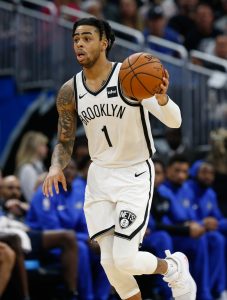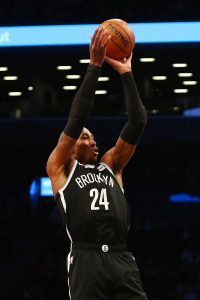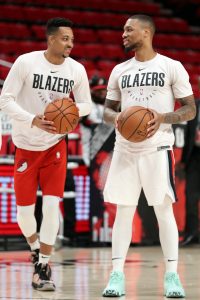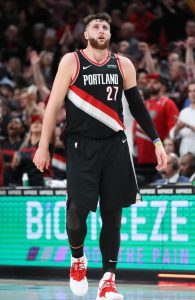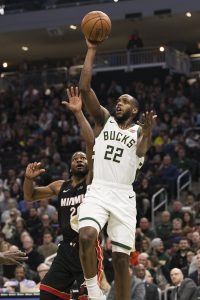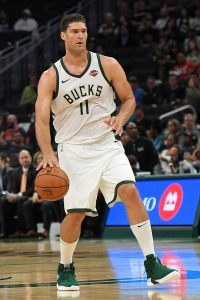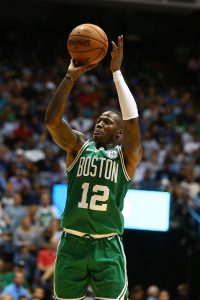The injuries raise questions about the Warriors’ ceiling for the 2019/20 season, but with a move to San Francisco on tap and a healthy Stephen Curry and Draymond Green still leading the way, one thing is clear: Golden State’s management has no intentions of taking a step back and retooling its roster.
Klay Thompson was never viewed as a serious threat to sign with any team besides the Warriors, and a Saturday report indicated that he’s planning to agree to terms with Golden State on a five-year, maximum-salary offer shortly after free agency begins. That leaves Durant as the Warriors’ primary concern.
Durant will also be eligible for that five-year max. In fact, because of his additional years of NBA experience, a five-year deal for KD would be worth about $31MM more than it Thompson’s own five-year deal — Durant’s maximum salary is worth over $221MM, while Klay’s falls just shy of $190MM.
Although he has opted for shorter-term contracts since arriving in the Bay Area, the time is right for Durant to shift his focus to long-term security. Because the Warriors now have his full Bird rights, he’s eligible for the first time to sign a five-year contract with the club — and that should look more appealing than ever after the injury he suffered in the Finals.
With no assurances that he’ll ever get back to being the same player he was before tearing his Achilles, Durant can’t count on a future contract to make up the $57MM he’d forfeit by signing a four-year, $164MM deal with another team.
Still, we don’t know exactly what Durant’s thinking heading into free agency. Is that extra year (and that $57MM) a significant factor for him? Is he upset at all about the way the Warriors handled his calf injury in the postseason? Did suffering that Achilles injury in Game 5 after pushing to make it back to the court bring him closer to his Warriors teammates?
I think a reunion with the Warriors is still a possibility, though I’m not sure it’s the most likely scenario at this point. We’ll find it in a matter of days what Durant is thinking.
2. What will the Warriors do next if they get a commitment from Durant?
With Thompson and Durant back in the fold, the Warriors’ team salary would balloon way into luxury-tax territory, limiting the team’s ability to make additional moves. However, it would become even more imperative that the Dubs add extra depth in that scenario, since it’s unreasonable for them to expect to get anything out of Thompson and KD in year one (Thompson may be able to return late in the season, but Durant likely won’t).
In that scenario, Andre Iguodala, Jacob Evans, Damian Jones, Alfonzo McKinnie, Jordan Poole, and perhaps Alen Smailagic and Eric Paschall would likely join Thompson, Durant, Curry, and Green, but the Warriors would have a hard time bringing back other key veterans.
Kevon Looney, especially, could get be in line for a big payday, and he’ll be an unrestricted free agent, meaning the Warriors won’t necessarily get the opportunity to match a big offer from a rival suitor even if they want to.
DeMarcus Cousins will also be unrestricted, and the Warriors won’t be able to offer him more than about $6.4MM, so he’ll likely be gone unless he’s willing to accept a team-friendly deal for a second consecutive year.
Shaun Livingston is under contract, but probably isn’t worth $7.7MM. The Warriors may opt to waive him and eat his $2MM partial guarantee, replacing him with a minimum-salary player.
Quinn Cook will be a restricted free agent, but his outside shooting stroke could make him a popular target for teams looking to fortify their backcourts and deplete the Warriors’ depth in one fell swoop.
Jordan Bell will also be a restricted free agent and may be easier to retain, since I’m not sure he’ll draw as much as interest as Cook. Still, if his cost exceeds his $1.82MM qualifying offer, Golden State will have to decide whether it’s worth it to retain him over a minimum-salary player.
3. Just how much are the Warriors willing to pay for this roster?
Even without bringing back any of their own free agents besides Thompson and Durant, the Warriors may end up with the most expensive roster in NBA history. Thompson, Durant, Curry, Green, Iguodala, Evans, Jones, McKinnie, Poole, and Livingston’s guarantee would cost nearly $157MM before accounting for tax penalties, and that’s only two-thirds of a full roster.
The Warriors have surpassed the Knicks and Lakers as the league’s highest-earning franchise over the last two years, according to Brian Windhorst and Ramona Shelburne of ESPN.com, and the move across the Bay should only improve the club’s financial standing. Team owner Joe Lacob has also said ownership is willing to spend whatever it takes to ensure that the Warriors remain a perennial title contender.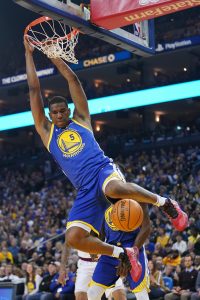
That’s clearly true when it comes to stars like Thompson and Durant, but what about the role players? If Looney gets an offer worth $10-12MM per year, would Golden State be ready to meet that price? If management determines that the team won’t be able to find an adequate replacement for Livingston at the minimum, would ownership be prepared to guarantee his $7.7MM salary?
A willingness to spend doesn’t necessarily mean a willingness to commit to unfavorable deals. But if the Warriors let those players go, they’ll have to find another way to add quality depth, which – as noted above – will be more important than ever this year, with Thompson sidelined and Durant out too (via injury or free agency).
The taxpayer mid-level exception (worth $5.72MM, plus exponentially more in tax penalties) and minimum-salary deals are options. The team could also potentially get a disabled player exception worth $9.26MM if Durant is deemed likely to be sidelined through next June 15. That could be used to sign or trade for a player on a one-year deal.
The Warriors’ decisions on their role players may come down to how confident they are in acquiring capable replacements on minimum-salary deals — if they don’t want to rely on bargain-basement additions, ownership’s stated willingness to spend will be put to the test.
4. What will the Warriors do if Durant leaves?
Without a $38MM+ cap hit for Durant on their 2019/20 books, the Warriors’ options don’t actually look much different. They’d still be on track to surpass the tax line, meaning they wouldn’t have the full mid-level exception available, and they’d still be limited in what they could offer a free agent like Cousins.
Still, it could make a difference that the team wouldn’t be starting the offseason $30MM+ over the tax line, where every dollar spent would cost an additional $5.75 in tax penalties. Aggressively matching offers for contributors like Looney and Cook, while also using the full taxpayer mid-level, would be much easier to stomach without a massive KD cap charge on the books.
Again, the Warriors have said they’re willing to spend whatever it takes to make this roster a contender, but with Durant on the cap, the cost of spending big on stars and role players starts to get a little crazy. Bobby Marks broke down the numbers over at ESPN.com, calculating that the difference between the cost of a roster with Durant (projected at $176.2MM in team salary) and without him ($139.7MM) would be more than $180MM in tax penalties for 2019/20 alone.
Common sense suggests that if Durant departs, the Warriors’ chances of retaining Looney, Cook, and others increase, while the odds of the team trying to make a modest splash in free agency using the taxpayer MLE and/or a disabled player exception also grow.
5. Is there a way for the Warriors to acquire another star if Durant leaves?
Based on the hypothesis that the Warriors will spend big on star players but may be reluctant to do so for role players, it’s reasonable to wonder if there a way for the Warriors to acquire a fourth star besides Durant to complement Curry, Green, and Thompson.
On the surface, it seems unlikely. The Warriors won’t have cap room and pulling off a sign-and-trade would be tricky, given their proximity to the tax apron. It’s also probably unreasonable to count on a former All-NBA player like Cousins falling into their lap for a second consecutive summer.
But there is one potential path to an impact acquisition for the Warriors if Durant leaves — sending him to his new team via sign-and-trade. Doing so would create the mother of all trade exceptions for Golden State, worth $30MM. That trade exception would be big enough to acquire nearly any player in the league without sending out any salary in return.
A sign-and-trade would be of no benefit to Durant, who would be eligible for the same max contract (in terms of both years and dollars) whether he signs outright with his new team or goes there via sign-and-trade. And the rest of his suitors – the Clippers, Knicks, and Nets – all have the room to sign him outright, or at least a clear path to open up that room, meaning it wouldn’t be of any real benefit to them either.
As such, the Warriors would have to sweeten the deal. If the Knicks, for instance, were offered the opportunity to acquire Durant and receive a draft pick or two from Golden State, they’d have to consider it. And for the Warriors, surrendering a first-round pick just to create a trade exception might be worth it — they haven’t exactly struck gold frequently with their late first-rounders in recent years.
Durant’s new team might not cooperate. And even then, there’s no guarantee that the Warriors would be able to trade for an impact player with the trade exception they generate. But it’s the sort of creative roster maneuver that the club figures to thoroughly explore as it enters what promises to be an unusual offseason.
Check out the Golden State Warriors’ offseason salary cap outlook right here.
Salary information from Basketball Insiders was used in the creation of this post. Photos courtesy of USA Today Sports Images.
